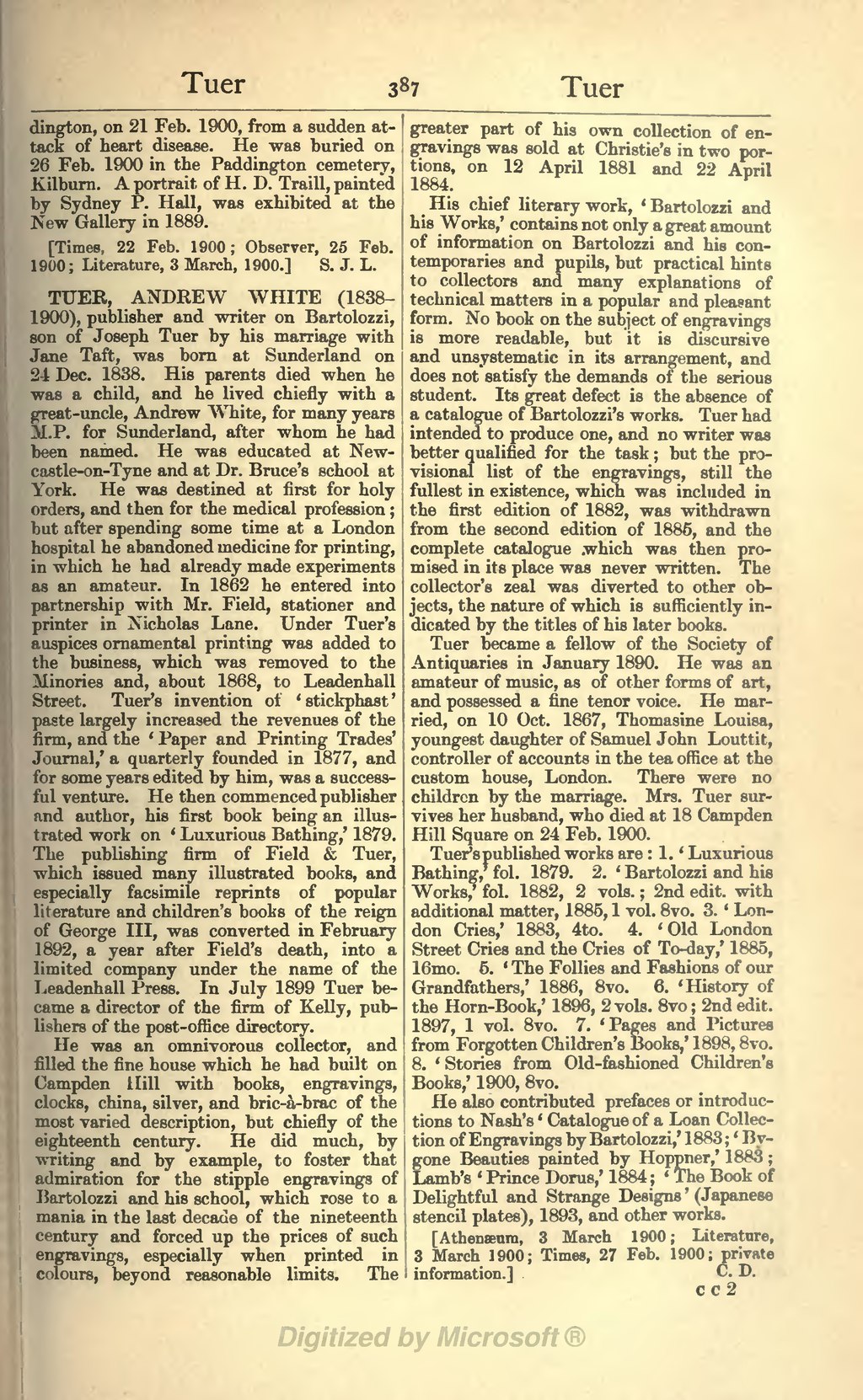dington, on 21 Feb. 1900, from a sudden attack of heart disease. He was buried on 26 Feb. 1900 in the Paddington cemetery, Kilburn. A portrait of H. D. Traill, painted by Sydney P. Hall, was exhibited at the New Gallery in 1889.
[Times, 22 Feb. 1900; Observer, 25 Feb. 1900; Literature, 3 March, 1900.]
TUER, ANDREW WHITE (1838–1900), publisher and writer on Bartolozzi, son of Joseph Tuer by his marriage with Jane Taft, was born at Sunderland on 24 Dec. 1838. His parents died when he was a child, and he lived chiefly with a great-uncle, Andrew White, for many years M.P. for Sunderland, after whom he had been named. He was educated at Newcastle-on-Tyne and at Dr. Bruce's school at York. He was destined at first for holy orders, and then for the medical profession; but after spending some time at a London hospital he abandoned medicine for printing, in which he had already made experiments as an amateur. In 1862 he entered into partnership with Mr. Field, stationer and printer in Nicholas Lane. Under Tuer's auspices ornamental printing was added to the business, which was removed to the Minories and, about 1868, to Leadenhall Street. Tuer's invention of 'stickphast' paste largely increased the revenues of the firm, and the 'Paper and Printing Trades' Journal,' a quarterly founded in 1877, and for some years edited by him, was a successful venture. He then commenced publisher and author, his first book being an illustrated work on ' Luxurious Bathing,' 1879. The publishing firm of Field & Tuer, which issued many illustrated books, and especially facsimile reprints of popular literature and children's books of the reign of George III, was converted in February 1892, a year after Field's death, into a limited company under the name of the Leadenhall Press. In July 1899 Tuer became a director of the firm of Kelly, publishers of the post-office directory.
He was an omnivorous collector, and filled the fine house which he had built on Campden Hill with books, engravings, clocks, china, silver, and bric-a-brac of the most varied description, but chiefly of the eighteenth century. He did much, by writing and by example, to foster that admiration for the stipple engravings of Bartolozzi and his school, which rose to a mania in the last decade of the nineteenth century and forced up the prices of such engravings, especially when printed in colours, beyond reasonable limits. The greater part of his own collection of engravings was sold at Christie's in two portions, on 12 April 1881 and 22 April 1884.
His chief literary work, ' Bartolozzi and his Works,' contains not only a great amount of information on Bartolozzi and his contemporaries and pupils, but practical hints to collectors and many explanations of technical matters in a popular and pleasant form. No book on the subject of engravings is more readable, but it is discursive and unsystematic in its arrangement, and does not satisfy the demands of the serious student. Its great defect is the absence of a catalogue of Bartolozzi's works. Tuer had intended to produce one, and no writer was better qualified for the task; but the provisional list of the engravings, still the fullest in existence, which was included in the first edition of 1882, was withdrawn from the second edition of 1885, and the complete catalogue .which was then promised in its place was never written. The collector's zeal was diverted to other objects, the nature of which is sufficiently indicated by the titles of his later books.
Tuer became a fellow of the Society of Antiquaries in January 1890. He was an amateur of music, as of other forms of art, and possessed a fine tenor voice. He married, on 10 Oct. 1867, Thomasine Louisa, youngest daughter of Samuel John Louttit, controller of accounts in the tea office at the custom house, London. There were no children by the marriage. Mrs. Tuer survives her husband, who died at 18 Campden Hill Square on 24 Feb. 1900.
Tuer's published works are : 1. 'Luxurious Bathing,' fol. 1879. 2. 'Bartolozzi and his Works,' fol. 1882, 2 vols.; 2nd edit, with additional matter, 1885, 1 vol. 8vo. 3. 'London Cries,' 1883, 4to. 4. 'Old London Street Cries and the Cries of To-day,' 1885, 16mo. 5. 'The Follies and Fashions of our Grandfathers,' 1886, 8vo. 6. 'History of the Horn-Book,' 1896, 2 vols. 8vo; 2nd edit. 1897, 1 vol. 8vo. 7. 'Pages and Pictures from Forgotten Children's Books,' 1898, 8vo. 8. 'Stories from Old-fashioned Children's Books,' 1900, 8vo.
He also contributed prefaces or introductions to Nash's 'Catalogue of a Loan Collection of Engravings by Bartolozzi,' 1883; 'Bygone Beauties painted by Hoppner,' 1883; Lamb's 'Prince Doras,' 1884; 'The Book of Delightful and Strange Designs' (Japanese stencil plates), 1893, and other works.
[Athenæum, 3 March 1900; Literature, 3 March 1900; Times, 27 Feb. 1900; private information.]
